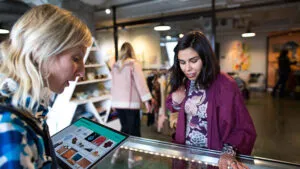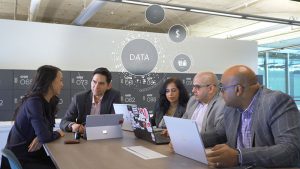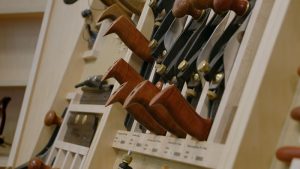
A universe of opportunities
OnWindows: Speak Magazine, Autumn 2014
Speak provides its readers with a quarterly digest of features, commentary and case studies focusing on the role of Microsoft technology in the retail, hospitality and consumer industries.

The Internet of things (IoT) has been the subject of a huge amount of press attention recently, and for good reason – it’s on track to spark the next digital revolution, and will have a significant impact on business and society alike.
There are a number of different definitions of this phenomenon. Gartner describes it as “the network of physical objects that contain embedded technology to communicate and sense or interact with their internal states or the external environment”. IDC refers to it as “a network of networks of uniquely identifiable endpoints (or ‘things’) that communicate without human interaction using IP connectivity – be it locally or globally.” Whichever definition you choose, there is one certainty: this rapidly expanding technology will increase exponentially in the coming years. Indeed, according to IDC, there will be over 212 billion devices connected to the internet by 2020. What’s more, the IoT will generate revenues of US$19 trillion dollars and will have five to ten times more impact on society than the internet. Some analysts have even predicted that it will be bigger than the industrial revolution.
For retailers and hospitality providers, this represents a huge opportunity. These industries have already undergone a period of significant transformation thanks to the rise of e-commerce. The IoT represents the next wave of disruption and will have an effect on all aspects of the sectors.
Perhaps the most obvious area in which the IoT will make its mark is within supply chain management. After all, retailers were the pioneers of RFID technology and the IoT is a natural extension of that. In this area we expect the IoT to enable retailers to take inventory tracking to the next level, dramatically improving supply chain efficiency and enabling leaner inventories.
The IoT will also help retailers to revolutionise the way in which they interact with their customers.
Coca-Cola Amatil, a leading beverage manufacturer in the Asia-Pacific region, provides an excellent example of this. The company has implemented an intelligent system from Microsoft and digital marketing agency TKM9 that uses interactive digital signage to create an immersive experience at its beverage coolers. The coolers are installed with three interfaces that customers can interact with in multiple ways. For example, they can take a picture with the integrated webcam, alter their appearances with different hairstyles and outfits, choose music, and login to Facebook to share the experience. They can interact through gesture and touch, and even use their mobile phones as a remote control.
The solution works with multiple data streams, including geolocation and facial recognition technology, social media input and weather services, to personalise the flow of content to individual customers in real time. CCA has the potential to use the data collected to refine product offers and cooler content. And TKM9 technologies can enable other capabilities, too. “Through the geolocation software on mobile phones, the solution can track the route customers take through a store or shopping centre to reach the cooler,” explains Mark Hodgens, TKM9’s CEO. “Then it can use the information to create ‘heat maps’ that optimise cooler placement as well as the display of other store products.”
The Co-operative Group has also leveraged the IoT to create a more personal customer experience. The UK-based supermarket chain has created a system that monitors transactions across thousands of stores, with information that can be drilled down to buying patterns for individual customers. Using Microsoft technologies including Microsoft SQL Server 2012 and Microsoft Azure, the Co-operative Group can process and analyse large amounts of data quickly, making the entire organisation much more agile.
This type of scenario offers a fountain of possibilities for the future. For example, by using facial recognition technology – such as that made possible through Xbox Kinect – retailers will be able to identify when a particularly loyal or valuable customer enters the store. The customer could then receive a personal welcome and have personal offers or discounts sent straight to their mobile device.
Other concepts are well underway, such as the Connected Fitting Room solution – an intelligent system powered by Microsoft and developed by Accenture. In the Connected Fitting Room, each garment in the store is labelled with an RFID tag. Then, inside the fitting room, there’s an RFID reader. So when a shopper walks into the room, that clothing uploads to the network and then it appears on a screen in the room. If the customer wants another size or colour, they simply tap the screen and a store associate will receive the notification to his or her mobile device and fetch the garment. This solution is really bringing the IoT and intelligent systems to life. It not only creates an engaging experience that encourages customers to buy (and buy more) but it also delivers deep insights into customer preferences and staff responsiveness, enabling retailers to make better merchandising and staffing decisions.
Predictive maintenance is another big advantage of IoT – a benefit that cruise operator Royal Caribbean has recently taken advantage of. The company’s new Oasis-class ships, the largest in the world, boast more than 2,700 staterooms and can carry up to 6,400 passengers. In the past, Royal Caribbean would ensure food safety on their ships manually: crewmembers equipped with probe thermometers and paper-based logs walked from galley to galley to manually check and record the temperature for each food item. For the new ships, with 11 sizable galleys and dozens of passenger service areas spread across four decks, Royal Caribbean determined that carrying out the inspection process the old way would take more than five hours – a tremendous burden given that the inspections must be repeated every eight hours.
“On an Oasis-class ship with hundreds of locations to check, we realised that a team of employees would have time for nothing but inspections during a shift,” says Bill Martin, vice president and chief information officer, Royal Caribbean. “We wanted to find a solution that would reduce their workload so that they could do other things.”
By leveraging the IoT using PARTech’s EverServ SureCheck system, food storage coolers are equipped with RFID tags that can be scanned from outside the closed door with a SureCheck device powered by Windows Embedded. Crew members use probe or infrared thermometers attached to the handheld devices to check individual food items in buffets and service areas. If the temperature reading exceeds safety limits, the crew member doing the inspection is automatically prompted to take corrective action, such as clearing dust from the fan vents in a cooler or discarding the buffet item; maintenance staff are also alerted if equipment needs to be repaired. The SureCheck system has cut food inspection from five hours per shift to two hours, freeing crew members for other tasks. Inspection records are loaded into the ship’s data systems to be quickly and securely relayed to the appropriate health inspection authorities when the ship is back in port.
This example can easily translate to retail. Large supermarket head offices, for instance, could use it to monitor the temperature of potentially thousands of freezers across their network of stores from a central dashboard connected via the cloud. This would allow them to see when a freezer isn’t running correctly, helping to minimise disruption to the customer, reduce the amount of waste stock and protect the bottom line.
Overall, it’s clear that the IoT offers vast potential for retailers and hospitality providers alike. However, we appreciate that it’s a daunting area and that many organisations don’t know where to start. That’s why, rather than thinking about the internet of things in terms of everything – such as billions of devices and sensors – retailers and hospitality providers should think of it as ‘The Internet of Your Things’. This means focusing on what matters most to the individual organisation and how more value can be unlocked from the data created in that organisation.
To find out more visit www.internetofyourthings.com





